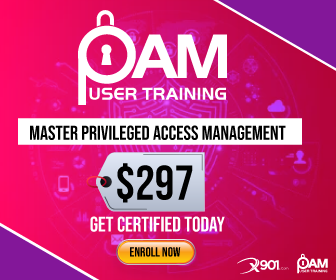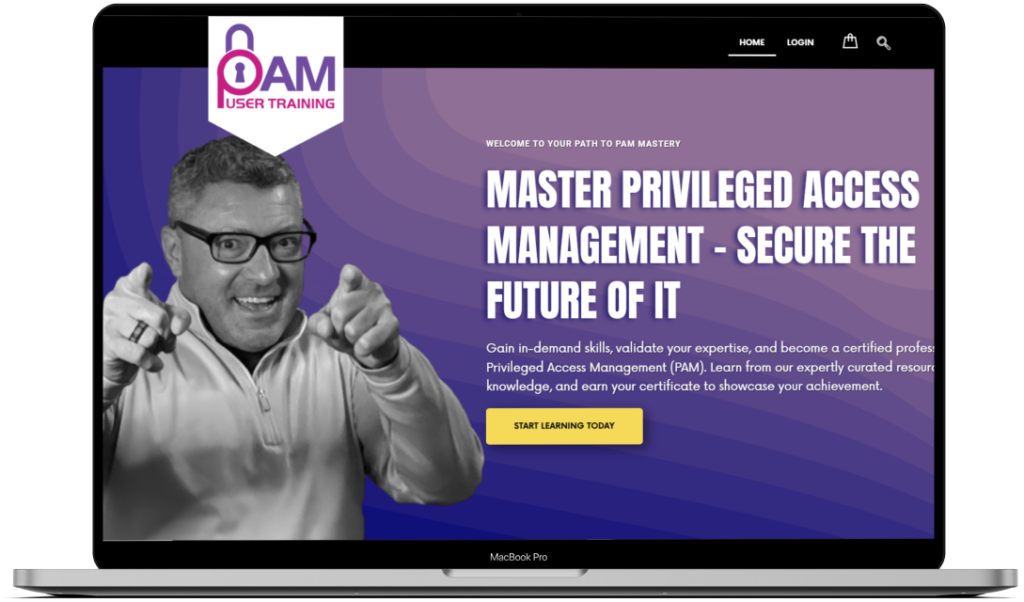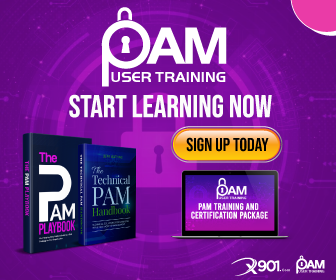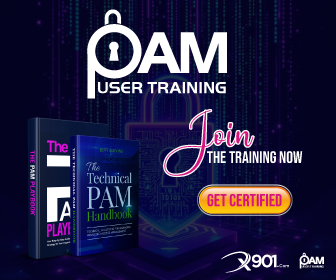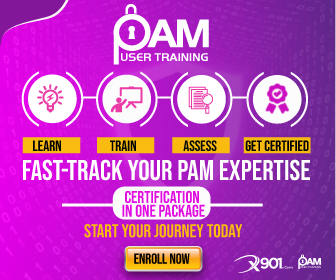Privileged Access Management (PAM) ROI Calculator
Cost Inputs
Savings Inputs
Total Costs: $0.00
Total Savings: $0.00
Net Benefit: $0.00
ROI: 0.00 %
The ROI of Privileged Access Management
Why It's Worth the Investment
Organizations must prioritize their cybersecurity measures in the modern digital landscape, where cyber threats are growing more complex, in order to safeguard critical data and preserve operational integrity. Privileged Access Management is a vital component of cybersecurity (PAM). This blog will examine the Return on Investment (ROI) of putting PAM into practice, emphasizing its worth, advantages, and the reasons why it’s a necessary investment for contemporary organizations.
YouTube
Just in Time Permissions Explained #Delinea #PAM #CyberSecurity
Welcome to PAMROI: Empowering Smarter Privileged Access Decisions
At PAMROI, we help businesses unlock the full value of Privileged Access Management (PAM) through education, data-driven tools, and immersive multimedia resources.
Informative Videos
Explore core PAM concepts through clear, engaging video explainers. Watch our popular “Just in Time Permissions Explained” to discover how on-demand access enhances security while reducing operational overhead. Stay tuned as we expand our library to cover topics like Role-Based Access Control, Credential Vaulting, and Threat Analytics.
Webinars and Tutorials
Join live or watch on-demand sessions led by PAM experts. These tutorials dive deep into complex topics—from implementation roadmaps to regulatory compliance. Perfect for IT leaders, security professionals, and compliance officers.
Interactive ROI Simulation
Our upgraded ROI calculator lets you model outcomes based on your organization’s specific parameters—number of users, type of assets, and security breach likelihood. See projected savings in real-time, helping you justify your PAM investment with confidence.
Predefined Industry Templates
Not sure where to start? Choose from curated templates tailored for common organizational types:
- Small Business
- Mid-Market
- Enterprise IT
- Healthcare
- Financial Services
These scenarios come pre-filled with industry benchmarks to give you a head start on ROI estimation.
Visual Results
Gain insights at a glance. Dynamic charts and graphs illustrate cost savings, risk reductions, and compliance improvements. Make compelling cases for stakeholders with visuals that tell a powerful story.
Case Studies
Read about real-world implementations from companies like yours. Learn how a financial firm reduced security incidents by 67% or how a healthcare provider met HIPAA requirements using a PAM solution. These success stories highlight both technical outcomes and business impacts.
Best Practices
Implement PAM with confidence using our expert guidelines. Topics include:
- Conducting a PAM risk assessment
- Defining access governance policies
- Integrating PAM with SIEM and IAM systems
- Measuring post-implementation ROI
PAM Glossary
New to PAM? Our easy-to-navigate glossary demystifies essential terms such as:
- Least Privilege
- Session Recording
- Credential Rotation
- Just-in-Time Access
A valuable resource for professionals at every level.
PAMROI bridges the gap between cybersecurity theory and business value. Our tools and resources are designed to:
- Accelerate understanding of PAM principles
- Drive informed technology investments
- Enhance your organization’s security posture
- Demonstrate measurable ROI

Secure More, Spend Less
Why PAM Is Worth the Investment
Protecting your business is more than just a necessity-it's an investment. Let's explore why Privileged Access Management (PAM) is a game-changer for your ROI.
PAM is all about controlling and monitoring accounts with elevated privileges. These accounts have access to vital systems and sensitive data-making them prime targets for hackers.
The financial fallout from a data breach can cripple a business. The average cost is a staggering $4.45 million.
PAM acts as a financial shield, significantly reducing the risk of breaches by controlling access to critical systems. By preventing unauthorized access, PAM helps you avoid the devastating financial and reputational damage associated with cyberattacks.
How Does PAM Protect Your Business?
Credential Vaulting: Safeguards your passwords with secure storage and management.
Session Monitoring: Tracks and records privileged sessions in real-time.
Least Privilege Enforcement: Ensures users only have access necessary for their roles.
Multi-Factor Authentication (MFA): Adds extra layers of security to verify identities.
PAM doesn't just enhance security-it delivers measurable financial benefits too. Here's how.
Compliance Made Easy: Navigating the complex world of regulatory compliance can be a minefield. Non-compliance can lead to hefty fines and legal headaches.
PAM provides the necessary controls and audit trails to ensure you meet the stringent requirements of regulations like SOX, HIPAA, and GDPR. Invest in PAM, and breathe easy knowing you're protected from costly penalties.
PAM Boosts Efficiency PAM isn't just about security; it's also about efficiency. By automating access management tasks, PAM frees up your IT team to focus on strategic initiatives. Automation reduces manual errors, streamlines workflows, and boosts productivity. No more time-consuming password resets and hello to a more efficient and secure IT environment.
PAM Strengthens Your Security PAM enhances security by implementing best practices like multi-factor authentication (MFA) and the principle of least privilege. This proactive approach results in fewer security incidents, reduced downtime, and lower costs for incident response and recovery.
PAM Builds Customer ConfidenceTrust is a valuable currency. Demonstrating a commitment to security through PAM builds confidence with your stakeholders, partners, and customers. This enhanced reputation can lead to stronger business opportunities, increased customer loyalty, and ultimately, greater profitability.
Calculating the ROI of PAM involves considering both tangible and intangible benefits. The formula is simple: ROI = (Net Benefits / Total Cost of Investment) x 100. Net benefits include savings from reduced breach costs, compliance fines, and operational inefficiencies, as well as the value of improved trust and reputation. By plugging in your organization's specific numbers, you can clearly see the financial advantages of investing in PAM.
To truly maximize ROI, follow these best practices
Conduct a comprehensive assessment of your privileged access landscape, prioritize high-risk accounts,
automate password management, integrate PAM with other security solutions, and regularly review and update your policies.
By optimizing your PAM implementation, you can ensure it continues to deliver exceptional value and protection.
Keep PAM Working for You: 1. Implement the Principle of Least Privilege: Regularly review and adjust access levels to minimize unnecessary privileges.
2. Automate Password Management: Use tools like credential vaulting and automatic rotation to reduce human error.
Integrate PAM for a United Front PAM doesn't exist in a vacuum. integrate it with your other security solutions, such as SIEM systems, to create a unified security front. this holistic approach enhances visibility, improves threat detection, and enables faster response times, ensuring that your business is well-equipped to handle any security challenge.
The cyber threat landscape is constantly evolving. To stay ahead of the game, regularly review and update your PAM policies. By adapting to new risks and changes in your IT environment, you can ensure that your PAM system remains effective and aligned with your security goals.
Table of Contents
- Key Risk Factors to Evaluate in Power Platform Solutions
- Categorizing and Prioritizing Power Platform Risks
- Methodology for Power Platform Risk Assessment
- Evaluating The User Experience lf Power Apps
- Accessibility Requirements for Power Apps
- Assessing the Adoption Rate of Power Platform Solutions
- How We Audit Power Apps and Power Automate
- What Makes Our Auditing Service Different
- Ensuring Compliance with Industry Standards
- Key Benefits of Auditing Power Apps and Power Automate
- How We Verify Compliance with GDPR and Other Regulations
- Identifying Gaps in Regulatory Compliance within Power
- Specific Compliance Standards Covered in Our Audit
- Handling Compliance Issues Found During the Audit
- Documenting Compliance Efforts for Regulatory Audits
- Detecting and Addressing Security Vulnerabilities in Power….
- Types of Security Threats Uncovered During Audits
- Testing for Weak Authentication and Access Control Flaws
- Ensuring Secure Handling of Sensitive Data in Workflows
- Identifying Risks from External Connectors or APIs
- Optimizing Power Automate Workflows for Better Performance
- Identifying Unnecessary Steps or Inefficiencies in Power Apps
- Metrics for Measuring Application Performance
- Improving App Speed and Reliability
- The Auditing Process for Power Apps and Power Automate
- Timeline for Auditing a Single Power App or Workflow
- Ongoing Monitoring vs. One-Time Audits
- Detailed Reports with Findings and Recommendations
- Assistance with Implementing Suggested Improvements
- Specializing in Industry-Specific Audits
- Examples of Improved Application Security from Audits
- Enhancing Compliance with Power Apps Workflows
- Case Study – ROI from Auditing Services
- Tools and Techniques Used During the Auditing Process
- Detecting Hardcoded Sensitive Information in Power Apps
- Assessing the Performance Impact of External Connectors….
- Handling Shared or System Accounts in Power Automate….
- Post-Audit Support for Fixing Identified Issues
- Setting Up Processes to Prevent Future Inefficiencies….
- Providing Developer Training for Ongoing Compliance….
- Frequency of Audits for Optimal Performance
- Next Steps to Start an Audit for Your Organization’s….
- Key Components of a Power Platform Application Audit
- Common Security Vulnerabilities in Power Apps and….
- Evaluating the Efficiency of Power Automate Flows
- Compliance Standards for Power Platform Applications
- Data Residency and Handling Requirements in Power….
- Evaluating the Effectiveness of DLP Policies in Power….
- Conclusion and Next Steps
Chapter 13
- Security Checks for Power Apps Custom Connectors
- Identifying Potential Data Leakage Points in Power Apps
- Authentication and Authorization Controls in Power….
- Auditing Power Automate Connection Security
- Conclusion and Next Steps
Chapter 14
- Metrics Indicating Inefficient Power Automate Flows
- Identifying Redundant or Duplicate Flows in Power….
- Best Practices for Evaluating Power Apps Performance
- Assessing Resource Usage in Power Platform Solutions
- Conclusion and Next Steps
Chapter 15
- Factors to Consider When Auditing Power Platform….
- Identifying Opportunities for Consolidating Power….
- Metrics to Determine the Cost-Effectiveness of Power
- Next Steps for Cost Optimization
Chapter 16
- Governance Policies to Check During a Power….
- Verifying Proper Environment Management in….
- Evaluating Access Control Policies
Chapter 17
- Key Components to Include in a Power Platform….
- Documenting Power Apps Dependencies and….
- Presenting Audit Findings in the Correct Format
Chapter 18
- Remediation Steps for Common Power Platform Issues
- Prioritizing Power Platform Audit Findings
- Suggested Timeline for Addressing Audit Findings
- Conclusion and Next Steps
Chapter 19
- Using Automated Tools to Audit Power Platform….
- Manual Checks During a Power Platform Audit
- Frequency of Power Platform Audits
Chapter 20
- Measuring the Business Impact of Power Platform….
- Metrics Demonstrating ROI for Power Platform Solutions
Chapter 21
- Auditing Integrations Between Power Platform and….
- Connection Security Checks
- Verifying Proper Error Handling in Integrations
Power Apps & Power Automate Standards

- Naming Conventions
- Control Names
- Variables and Collection Names
- Apply automatic formatting
- Flatten Nested IF Conditions
- Load Multiple Datasets Concurrently
- Cache Data in Collections
- Enable formula Level Error Management
Validate Form Data
- Required fields are not blank
- Proper formatting for phone numbers, email addresses, postal codes, URLs, dates, etc.
- Number fields are within the allowed minimum and maximum range
- Confirmation fields are matching (passwords, etc.)
App Checker
- Code Comments
- Create Child Flows To Store Repetitive Logic
Always Build Flows Inside Of A Solution
- Build flows inside of a solution so they can be easily transported across environments.
Secure Inputs/Outputs For Passwords, API Keys and Secrets
- Credentials coming from Azure Key Vault, [P@MSvpq`j, etc. should never be displayed in the flow run history. Change the flow action settings to secure inputs/outputs for every step where sensitive information is showing.
Enable Elevated Permissions By Configuring Run As User
- Power Automate flows are run in the context of a user account. The user account is what determines the permissions a flow has.


Decide Whether To Use Premium Flow Connectors
- Keep The 30 Days Flow Duration Limit In Mind
- Enable Concurrency Control In Apply To Each Loops
- Execute Flow Actions In Parallel Branches
- Stay Below The Data Connector API Limits
Try, Catch, Finally Pattern
- Try – Attempt to execute one or more flow actions
- Catch – When an error occurs, do these steps next
- Finally – always run these actions whether the previous actions succeeded or failed
Group Multiple Actions Inside Of A Scope Action
When multiple actions have the same error-handling requirements place
them inside a scope action. A scope action holds a set of other actions.
Assign Connection Ownership To Service Accounts
A Service Account with the System Administrator security role should own
the connections being used by connection references.
7 Reasons Your PAM Journey is not Working
Investing in Privileged Access Management offers substantial financial rewards through risk mitigation, compliance, operational efficiency, and trust-building, while also strengthening security. As cyber threats continue to evolve, securing privileged accounts is imperative. The ROI of PAM positions it as a strategic choice for organizations aiming to protect their assets and thrive in a digital world.
By understanding and leveraging the ROI of PAM, organizations can secure their future while maximizing current operational efficiency and financial success.
Lack of Comprehensive Strategy:
Without a clear, overarching PAM strategy, efforts become disjointed and ineffective. Organizations need a well-defined roadmap that aligns with business goals and security requirements.
Insufficient Executive Buy-In:
Successful PAM implementation requires strong support from top management. Without executive sponsorship, securing necessary resources and prioritizing PAM initiatives becomes challenging.
Inadequate User Training:
Users need to understand the importance of PAM and how to use PAM tools effectively. Inadequate training leads to misuse or avoidance of PAM systems, undermining security.
Complexity of Integration:
PAM tools must integrate seamlessly with existing systems. Complexity in integration can lead to operational disruptions and inefficiencies, making it harder to enforce privileged access controls.
Neglecting Regular Audits:
Regular audits are essential to identify and rectify gaps in PAM policies. Without consistent audits, vulnerabilities may go unnoticed, leading to potential security breaches.
Overlooking Endpoint Security:
Focusing solely on user credentials and ignoring endpoint security creates significant risks. Endpoints need robust protection as they can be entry points for attackers to exploit privileged access.
Failure to Adapt to Changing Threats:
Cyber threats are constantly evolving. Stagnant PAM strategies that don't adapt to new threats and technologies become obsolete, leaving organizations vulnerable.
Understanding Privileged Access Management
Privileged Access Management involves controlling and monitoring accounts with elevated permissions, commonly referred to as privileged accounts. These accounts often have access to sensitive information and critical systems, making them prime targets for cyber attackers. PAM solutions protect these accounts through various techniques, including:
- Credential Vaulting: Secure storage and management of passwords.
- Session Monitoring: Real-time tracking and recording of privileged sessions.
- Least Privilege Enforcement: Ensuring users have only the access necessary for their roles.
- Multi-Factor Authentication (MFA): Adding layers of security to verify user identities.
The ROI of PAM:
Quantifying the Benefits
Reduced Risk of Data Breaches:
Data breaches can have devastating financial consequences. According to IBM's 2023 Cost of a Data Breach Report, the average cost of a data breach is $4.45 million. By restricting and monitoring access to critical systems, PAM significantly reduces the risk of breaches. This prevention helps organizations avoid the substantial financial and reputational damage associated with data breaches.
Compliance and Avoidance of Fines
Regulatory compliance is a significant concern for many industries. Noncompliance can lead to legal repercussions and hefty fines. PAM provides the necessary controls and audit trails to help organizations comply with regulations such as SOX, HIPAA, and GDPR. Investing in PAM allows organizations to avoid costly fines and legal issues, offering a clear financial benefit.
Operational Efficiency and Cost Savings:
PAM solutions reduce the burden on IT staff by automating many access management tasks. Automation leads to fewer human errors, streamlined workflows, and increased productivity. For example, credential vaulting eliminates the need for frequent password resets, saving time and money. Overall, automation within PAM can lead to significant cost savings.
Enhanced Security Posture
A robust security posture is crucial for protecting an organization's assets and reputation. PAM enhances security by implementing best practices like MFA and least privilege principles. Improved security measures result in reduced downtime, fewer security incidents, and lower costs for incident response and recovery.
Improved Trust and Reputation
Stakeholders, partners, and customers expect organizations to protect their data. Implementing PAM demonstrates a company's commitment to security, building trust and enhancing its reputation. This can lead to better business opportunities, increased customer loyalty, and potentially higher revenues.
Investing in Privileged Access Management offers substantial financial rewards through risk mitigation, compliance, operational efficiency, and trust-building, while also strengthening security. As cyber threats continue to evolve, securing privileged accounts is imperative. The ROI of PAM positions it as a strategic choice for organizations aiming to protect their assets and thrive in a digital world.
By understanding and leveraging the ROI of PAM, organizations can secure their future while maximizing current operational efficiency and financial success.
YouTube
OATH OTP MFA Explained: Easy Setup Guide for Stronger Security
Calculating ROI:
A Practical Approach
To calculate the ROI of PAM, organizations should consider both tangible and intangible benefits. Here’s a simplified formula:
ROI=Net BenefitsTotal Cost of Investment × 100\text{ROI} = \frac{\text{Net Benefits}}{\text{Total Cost of Investment}} \times 100ROI=Total Cost of InvestmentNet Benefits×100
Where:
Net Benefits = Total Savings and Revenue Increases – Total Costs
Total Cost of Investment = Cost of PAM Solution + Implementation + Maintenance
Example Calculation:
Total Savings and Revenue Increases:
Reduced breach costs: $1,000,000
Compliance savings: $200,000
Operational efficiency savings: $100,000
Improved trust/reputation value: $50,000
Total: $1,350,000
Total Costs:
PAM Solution: $300,000
Implementation: $50,000
Maintenance: $50,000/year (for simplicity, consider 1 year)
Total: $400,000
ROI = 1,350,000 − 400,000400,000 × 100 = 237.5%\text{ROI} = \frac{1,350,000 – 400,000}{400,000} \times 100 = 237.5\%ROI=400,0001,350,000−400,000×100=237.5%
This example demonstrates a significant ROI, underscoring the financial viability of investing in PAM.
Purchasing Privileged Access Management offers significant financial rewards through risk mitigation, compliance, operational effectiveness, and trust-building, in addition to improving security. It is imperative to secure privileged accounts because cyber threats are always evolving. PAM’s return on investment (ROI) positions it as a strategic choice for businesses looking to protect their assets and prosper in a world becoming digital.
Organizations can safeguard their future while maximizing their current operational effectiveness and financial success by comprehending and utilizing the ROI of PAM.
Best Practices for Maximizing ROI on Privileged Access Management

YouTube
Delinea Platform Multi Factor Authentication Everywhere
Before implementing a PAM solution, thoroughly review your current privileged access landscape. Identify all access points, privileged accounts, and potential vulnerabilities. This baseline information will guide your PAM strategy, helping to minimize unnecessary investments and address the most critical areas.
Not all privileged accounts carry the same level of risk. Focus on securing high-risk accounts, such as those with access to critical systems or sensitive data. Prioritizing these accounts will immediately enhance risk reduction and accelerate ROI.
Ensure users have only the minimum access necessary to perform their duties. Regularly review and adjust access levels to prevent privilege creep, which occurs when users gradually accumulate unnecessary access privileges. Reducing undue privileges lowers the attack surface and improves overall security.
Automate password management with features like credential vaulting and automatic rotation. Automated systems ensure passwords are complex, unique, and regularly updated, reducing administrative burden and human error, and lowering the likelihood of credential breaches.
Implement MFA to add an extra layer of security by requiring users to verify their identities through multiple methods. MFA significantly reduces the risk of unauthorized access, especially in remote and high-risk environments, protecting your most sensitive data.
Real-time monitoring and auditing of privileged sessions allow you to observe user activities and detect suspicious behavior. By promptly identifying and addressing potential security issues, you can prevent costly breaches and compliance problems.
Cybersecurity is a constantly evolving field. Regularly review and update your PAM policies to address new threats and changes in your IT environment. Staying proactive ensures your PAM system remains effective and aligned with your security objectives.
Enhance overall security visibility and response capabilities by integrating PAM with other security solutions, such as Security Information and Event Management (SIEM) systems. This comprehensive approach allows for better correlation of security events and more efficient threat mitigation.
Ensure all users, especially those with privileged access, receive regular training on PAM and cybersecurity best practices. Informed users are less likely to make mistakes that could compromise security, enhancing the effectiveness of your PAM solution.
Continuously monitor the performance of your PAM system against key metrics such as reduced incidents, compliance adherence, and operational efficiency. Use these insights to address any gaps or inefficiencies that could impact your ROI.
Maximizing ROI on Privileged Access Management requires a strategic and proactive approach. Organizations can achieve significant cost savings and improve their security posture by automating password management, enforcing strict access controls, prioritizing high-risk accounts, and integrating with other security systems. Regular reviews, training, and performance optimization ensure the PAM system remains effective and valuable over time. Implementing these best practices will help you get the most out of your PAM investment while protecting your organization’s most critical assets.





